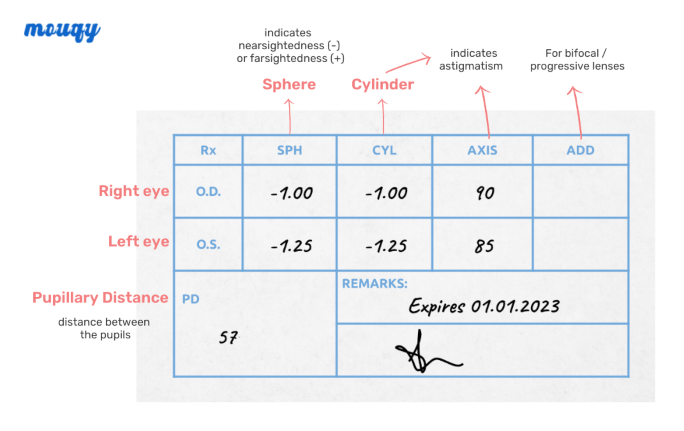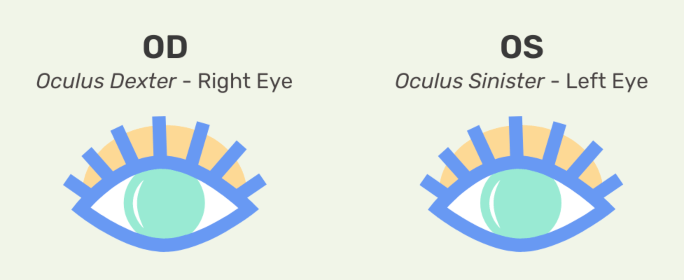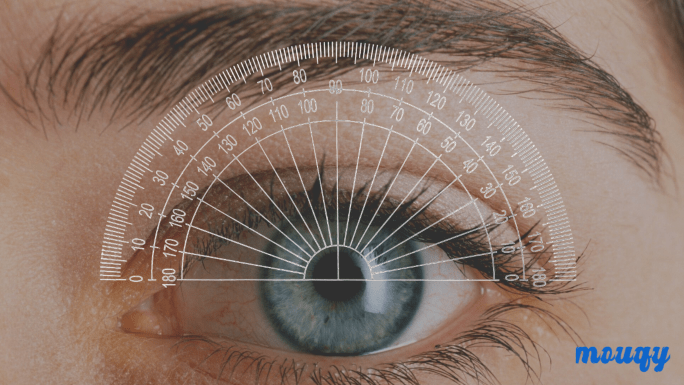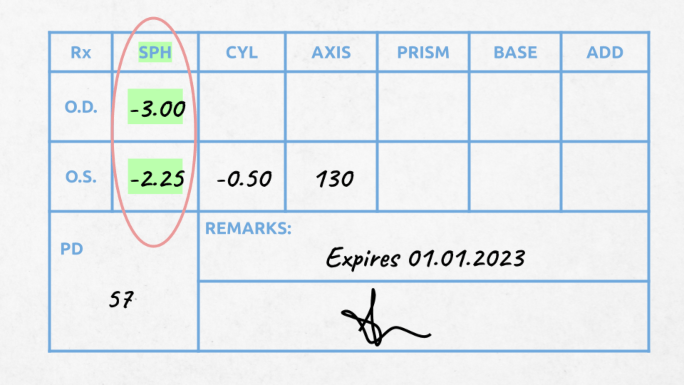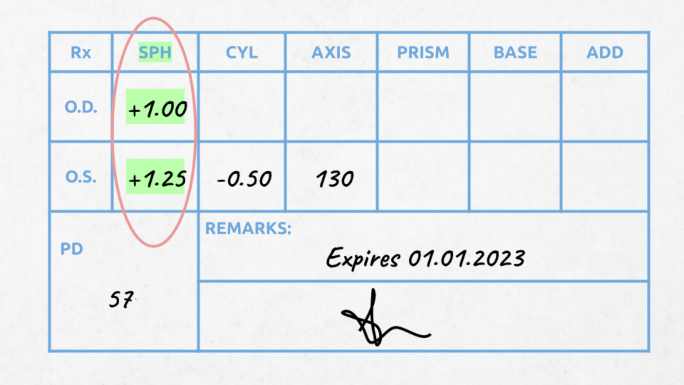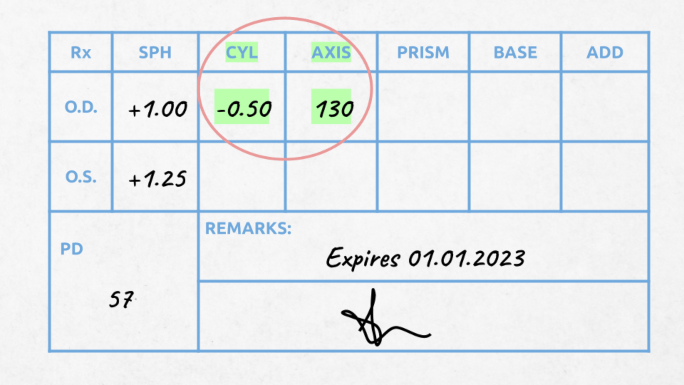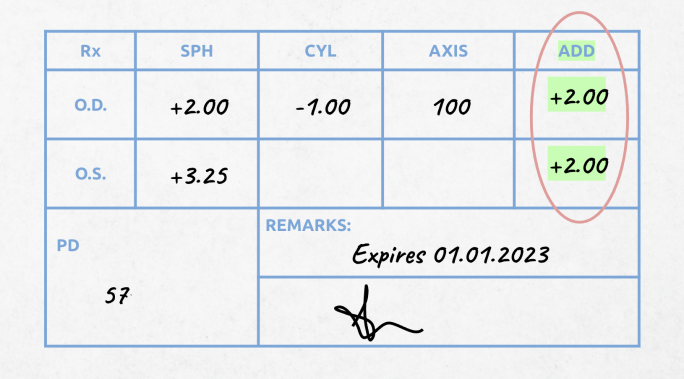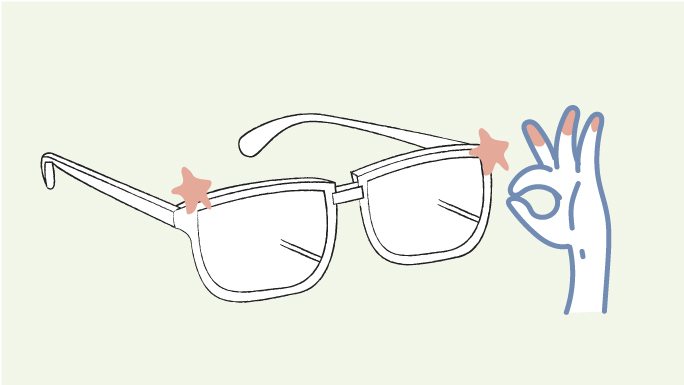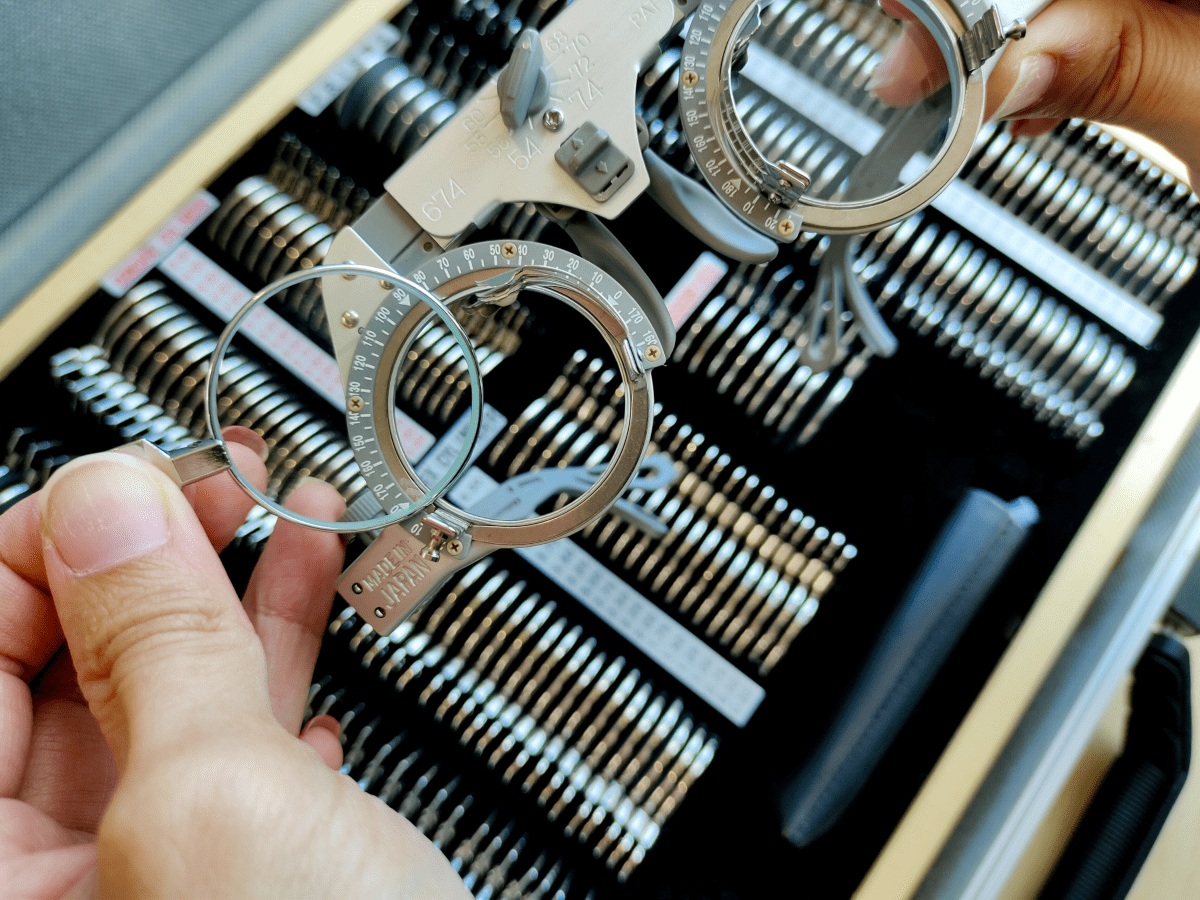If your eye prescription has you puzzling and scratching your head – you’re not alone! However, if you’re buying new glasses, it’s very important that you can make sense of it. How else can you ensure your new lenses will suit your eyes?
Prescriptions are often riddled with optometric jargon. To add to the confusion, different people have different visual needs. Some are nearsighted, some farsighted and some have astigmatism. To help you decode the numbers and abbreviations on your prescription, we’ve created this guide with clear examples and explanations, so you’ll know exactly how to navigate yours.
Your eyeglass prescription in at nutshell
Let’s start by looking at an example eyeglass prescription chart that your eye doctor might give you.
They can come in a few different forms, but the most common in the US is the Standard Grid Format. It usually looks something like this.
Eye prescriptions are made up of abbreviated letters and numbers that represent different components of your visual needs.
Let’s take a closer look at what these abbreviations mean.
OD and OS
“OD” and “OS” simply refer to your right and left eyes. Eye doctors make this distinction because your eyes will often have slightly different corrective needs.
Eye doctors typically use the Latin abbreviations “OD” and “OS”. That said, some prescriptions these days will literally say ‘right eye’ and ‘left eye’.
Sphere (SPH)
Sphere or SPH is an indication of the amount of power needed in the lenses for someone to experience optimal vision correction. SPH is measured in diopters (D).
The greater the distance of the SPH from 0, the more power your lens needs in order to be corrected. For example, if your SPH reads +1.00, that means your lenses need 1 diopter of strength to correct farsightedness. A reading of -5.00 would require 5 diopters of strength to correct nearsightedness.
SPH also helps indicate whether you are nearsighted or farsighted.
- If your sphere number comes with a minus symbol (-), this means that you are nearsighted.
- If your sphere number comes with a plus symbol (+), this means that you are farsighted.
We’ve included a section on nearsighted and farsighted prescriptions later on in this guide.
Cylinder (CYL)
The Cylinder or CYL refers to the power needed in the lens to correct astigmatism.
There are nearsighted astigmatism and farsighted astigmatism as well, and the corrections for these are represented in the symbols.
- A minus symbol (-) means you need correction for nearsighted astigmatism.
- A plus symbol (+) means you need correction for farsighted astigmatism.
If there’s no indication of any symbol in this column, congratulations! You either don’t suffer from astigmatism, or the condition is so minor that no correction is needed.
Axis
The number marked ‘Axis’ refers to the orientation of astigmatism. If the lens prescription comes with a “Cylinder” value, it will also typically include an “Axis” value, which follows the cylinder power. Unlike the SPH and CYL, the Axis reading is not measured in diopters, but degrees. This is measured by superimposing a protractor on the eye’s front surface. The value usually falls between 1 – 180.
In short, the Axis value combined with the Cylinder value is what’s needed to correct astigmatism.
Add
If you require multi-focal lenses, such as bifocals or progressive lenses, then you’ll also see an ‘Add’ value in your prescription. Add refers to the added magnifying power and is typically used to correct presbyopia (farsightedness caused by aging). It applies to the lower part of multifocal lenses.
Normally, the power for both eyes will range from +0.75 to +3.00 D, and will usually be consistent for both eyes. The number is always read a “Plus” power, even if it’s not explicitly stated so in the prescription.
Prism / Base
Prism and base value is prescribed to correct eye alignment issues (for example double vision, or a ‘lazy eye’). This is slightly less common, and is indicated on your prescription with two values: Prism and Base. These values tell us what shape the lens needs to be in to accurately provide optimal vision correction for the wearer.
Typically, the base values will either be “in” or “out” / “up” or “down”, which refers to the direction the lens should be tilted towards.
PD
PD is short for Pupillary Distance, which is the distance between the center of one pupil to the center of the other pupil. PD is one of the most important things to understand in their prescription, because it ensures that you are looking through the ideal spot in your lenses.
You’re typically given just 1 set of numbers for your PD, but if you’re given 2 sets of numbers, it just means you were prescribed using dual PD. If you weren’t prescribed a PD value during your visit to your eyecare professional or if you simply forgot, don’t worry. You can measure your PD yourself from home.
Put it together to decode your eye prescription
So, let’s revisit that prescription chart from earlier, and put our newfound knowledge to good use!
From this prescription, we can tell that:
- The patient requires single-vision glasses (note that the ADD column is blank).
- Patient is nearsighted (the SPH values have a minus sign).
- Mild astigmatism is detected in both eyes.
- No prism correction is required.
For the right eye (OD), the doctor prescribed:
- -1.00D sphere to correct nearsightedness.
- -1.00D CYL at 90 axis to correct astigmatism
For left eye (OS), the doctor prescribed:
- -1.25 D sphere for nearsightedness correction.
- -1.25 D CYL at 85 axis to correct astigmatism.
Example of a nearsighted prescription
A nearsighted prescription will have a SPH number with a minus (-) symbol.
Nearsightedness, or myopia, is a common refractive disorder estimated to affect 25% of Americans, according to the American Academy of Ophthalmology. It means that you’re able to see nearby objects clearly, but objects that are further away may appear blurry.
The more nearsighted you are, the greater the SPH number distance from 0. For example, a SPH of -3.00 is a stronger prescription than -1.00. The strength can vary for each eye.
Example of a farsighted prescription
A farsighted prescription will have a SPH number with a plus (+) symbol.
Farsightedness, or hyperopia, is a condition that can make objects that are close by to appear blurry. This can lead to eyestrain and headaches since nearby things are harder to see.
The more farsighted you are, the higher your SPH number will be on your prescription.
Example of an astigmatic prescription
An astigmatic prescription will be indicated if you have values written under the CYL and AXIS boxes. The CYL may be negative or positive.
Astigmatism is another very common condition caused by an irregular curve in the lens or in the cornea of your eye.
This can affect the way light hits your retina, which in turn can distort the images you see, or cause objects that are nearby or far away to look blurry.
Your prescription will tell you how severe your astigmatism is (CYL) and where the irregular curve appears on your eye (AXIS).
Example of a multi-focal lens prescription
Some people require bifocal or progressive glasses, which have multiple strengths within the lens, allowing people to see both near and far objects.
This is indicated with the ADD column.
As we’ve mentioned, this Add figure indicates the additional magnifying power you need in the lower part of a multifocal lens, and is always positive (+).
Do I need a new eyeglass prescription?
It’s important to note that your eyeglass or contact lens prescription isn’t a one-time-deal situation. Over time, your vision can change.
Most eyewear prescriptions are good for 1 or 2 years from the date of your last eye exam, but our vision can be quite fragile and require more correction, especially if they’re constantly in use and put under strain.
If you haven’t visited your eyecare professional in more than a year, it’s highly recommended to schedule an eye exam as soon as possible to get a new prescription.
It’s actually a legal requirement in the US for your eye doctor to give you a copy of your eyeglass prescription after any eye exam that includes a refraction. You should be given a copy of your prescription even if you don’t ask, and you should never need to pay extra! This is a clause in the Federal Trade Commission (FTC) that protects your freedom to buy glasses from any vendor you like!
Can eyeglass prescriptions be used to buy contact lenses?
No, you cannot use your glasses prescription to buy contact lenses.
That’s because contacts and glasses work in totally different ways. Contact lenses are in direct contact with your eye, and need to conform to the curves of your eye.
A contact lens prescription will therefore contain specific measurements such as the base curve and lens diameter, as well as the brand, type, and expiry date of the lens. They also need to be updated yearly. To get this information, you should arrange a contact lens fitting at your nearest eye doctor.
Got your prescription? Start browsing the Mouqy collection!
If you’ve gotten your prescription and understand how to read it, then you’ll have nothing to worry about when it comes to shopping for your new pair of Mouqy eyeglasses!
Start browsing our wide selection of eyeglasses today and find your perfect pair that matches your eyeglass prescription.
You can click on this link to continue shopping, or click here to learn more about eyecare.








